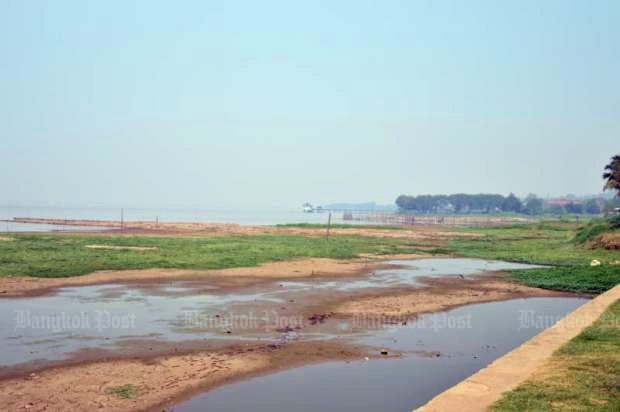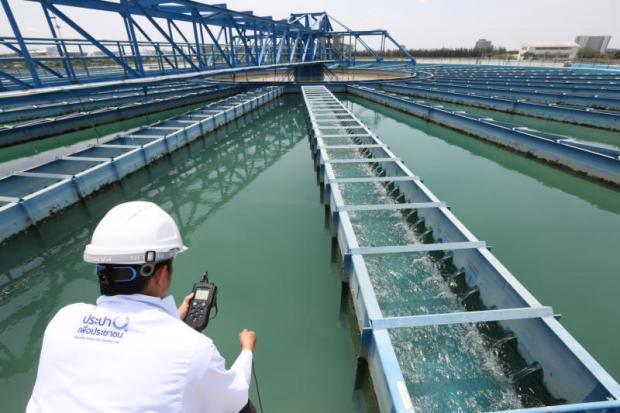
The arrival of long-awaited rain this month has brought relief across large swathes of Asia from one of the worst heatwaves in decades. But the impact of the recent drought will be felt for months to come in the form of lower crop output, higher food prices and economic hardship for farmers.
The strongest El Nino since the record event of 1997-98 caused widespread dry conditions with water levels in many key reservoirs in Thailand falling below 20% of their storage capacity, the lowest since 1994. In Vietnam, water in the Mekong delta was so low that salinity was found as far as 100 kilometres upstream, destroying rice crops.
Major reservoirs were also depleted in Malaysia where the average daily temperature of 30.6 degrees Celsius in April was an all-time high. Thailand endured the longest heatwave in five decades with an all-time high temperature of 44.6C recorded in late April in Mae Hong Son, beating a record that had stood since 1960.
Some relief is in sight as El Nino has finally run its course. Now forecasters are assessing the potential impact of La Nina. In India, where temperatures soared as high as 51C and tens of millions endured water shortages, experts are predicting the best monsoon since 1994.
The Thai Meteorological Department is forecasting average annual rainfall in June to be slightly below normal in the North, Northeast, Central and Southern regions. For the rest of the rainy season through the end of September, it expects near-normal rainfall. It defines slightly below normal as accumulations between 10% and 25% below historical averages, while near-normal is less than a 10% deviation above or below the average.
In the 30-year period from 1971 to 2000, according to department data, average rainfall was 1,573 millimetres. In 2011, the year of the catastrophic floods, rainfall totalled 1,950mm. Last year, however, accumulations were only 1,400mm. Overall, the forecast is for above 1,700mm this year.
For now, however, consumers are dealing with the reality of reduced supplies of staples and higher prices resulting from the dry conditions of the past several months. The Thai Rice Packers Association warned earlier that its members might have to increase the prices of packaged rice by September if new supplies cannot be secured.
Milled rice prices are currently around 14,000 baht a tonne compared with 12,000 baht earlier in the year. The Thai Rice Exporters Association was quoting benchmark prices for 5% Thai rice at a two-year high of US$441 a tonne last week, up from $397 a month earlier.
Thailand's total rice production, including the main and second crops, fell to 27.4 million tonnes in 2015-16, the lowest since 2000-01, according to the Office of Agricultural Economics. It forecasts that the main crop this year, which is typically planted in May and accounts for about 80% of the country's output, may increase to 25.2 million tonnes from 23.5 million a year earlier.

An official checks water quality at the Bang Khen treatment plant in Bangkok. The drought has caused increases in salinity that must be carefully monitored.
The US Department of Agriculture released a forecast in March that production of polished rice in Thailand would decline 18.9% to 15.8 million tonnes this year. Rainfall since the beginning of this year was even lower than in the same period last year, when the amount of precipitation sank to a 26-year low.
World rice production is expected to decline this year for the first time since 2010. Rice inventories in the three top exporters -- Thailand, India and Vietnam -- are set to fall by about a third at the end of 2016 to 19 million tonnes, the biggest year-on-year drop since 2003, according to Reuters calculations based on US Department of Agriculture data.
Any big supply disruption can be extremely sensitive. In 2008, lower Asian rice output resulting from El Nino prompted India to ban exports, sending global prices skyrocketing and causing food riots in Haiti and panic measures in big importers such as the Philippines. Benchmark Thai rice prices hit a record of $1,000 a tonne that year.
QUALITY SUFFERS
Beyond staple foods, declining yields have also affected the availability of fruits, vegetables and perennial plants. Quality has suffered as well because of the dry conditions, with high nitrate levels in pineapples and less sweet watermelon, according to the Economic Intelligence Center (EIC) of Siam Commercial Bank.
The effects are being felt most keenly by low-income consumers as higher food prices cut into disposable income, with a knock-on effect throughout the economy.
Vegetable prices in Singapore have jumped by 40% this year because of reduced exports from water-short Malaysia, which contributes 43% of the vegetables consumed in Singapore, according to a report in the Straits Times.
In Myanmar, the price of betel leaves chewed by many people has tripled, according to wholesale sellers who told the Myanmar Times they had been forced to cut back their stocks, while hawkers say they are struggling to make their usual daily wage.
"The decline in harvests in many places will definitely lead to low supplies and therefore higher prices of commodities," said Sanny Jegillos, senior adviser for disaster risk reduction and recovery with the United Nations Development Programme (UNDP) regional office in Bangkok.
However, EIC points out that the prices of some major agricultural commodities such as rice, sugar and cassava, particularly in Thailand, may not increase as much as they did after the previous major drought in 2005. This is because of high inventories resulting from production surpluses in recent years.
Another commodity to watch closely is palm oil, which is used in countless products. Crude palm oil prices are expected to rise this year because of lower yields resulting from the impact of El Niño, said Zakaria Arshad, chief executive of Malaysia-based Felda Global Ventures, the world's third largest palm plantation operator.
Lower palm output in Indonesia and Malaysia, the world's two largest producers in, is expected to lift prices to an average of 2,500 ringgit ($607) per tonne this year, up from 2,275 ringgit last year, he said.
In Thailand, the drought during the first three months of this year caused economic damage of up to 80 billion baht, chiefly to agricultural production, according to Chawalit Chantararat, an expert on water management and chief executive officer of TEAM Group of Companies.
Lower rice output, he said, had not had too much impact on the national level. However, it would affect the financial capability of individual farming households, especially those in upland areas that lack the capacity to store water for low-rainfall periods.
Agriculture accounts for 11% of gross domestic product in Thailand, and 18% in India and Vietnam. Experts say declining farm production in these countries would lower GDP growth because of weaker domestic consumption and lower exports as food prices increase.
For Thailand, EIC predicts that farm income losses may push already high household debt levels up even further, especially for those with existing obligations. Farm-related businesses such as companies that sell fertilisers, herbicides, pesticides, farm equipment and tractors would lose business. Food processors will have to deal with more expensive but lower-quality crops, but some may not be able to pass on those costs to customers because of high competition.
Overall, EIC estimated that the drought could reduce Thailand's GDP by about 0.5% this year.
The impact from El Niño may also be felt on tourism because the warming ocean causes coral bleaching, affecting the attractiveness of diving destinations. Some tourism sites in the region are reported to have closed to deal with the problem, said Mr Jegillos at the UNDP.
In Cambodia, he said, the most severe impact has been in the provinces around Tonle Sap, the biggest lake in Southeast Asia. Residents have long depended on the lake to support their farming and fishing livelihoods, but low water levels have forced many to seek other ways to earn income.
ASEAN UNPREPARED
"As for the countries of Southeast Asia, in the past they were water-rich areas, so they were less prepared for drought. The impact of the drought on these countries is severe," said Li He, natural resources officer with the UN Food and Agriculture Organization (FAO) regional office in Bangkok.
Agricultural yield losses exacerbate rural poverty. Since many farmers have no other job skills and lack the capacity to deal with the effects of the drought, they can become desperate as their economic situation deteriorates, she said.
Water scarcity can also affect industries that require a lot of water for production, she pointed out. Fighting the drought also consumes large amounts of energy, which might also restrict an industry's consumption.
"All of these would have negative impacts on the industrial sector. We could say that water scarcity caused by severe drought can intensify social conflicts," she said.
Low water levels also lead to increased risk of contamination and salinity in household water supplies, according to EIC. At least 35 provinces in Thailand had been declared water-scarcity areas as of mid-May. However, the impact has been alleviated to some degree, with authorities providing water trucks, developing new underground water sources and carrying out rainmaking.
In Vietnam, the most severe drought in more than 60 years has left many parts of the country in a state of emergency. Since mid-2015, the FAO reports, 52 of 63 provinces -- more than 83% of the country's area -- have been affected by drought, with 18 severely affected as of May 11. This has left at least 2 million people suffering acute water shortages and requiring humanitarian assistance.
Crop damage has been severe in many vulnerable communities, with 60-90% of planted crops harmed and planting for the new season not possible until shortly before the rainy season. As a result, an estimated 1.75 million people in the agricultural sector have lost their incomes, according to the FAO.
Mr Chawalit of TEAM Group said while the monsoon season was officially said to have begun on May 16, low humidity from El Niño will mean reduced rainfall volumes until mid-June, indicating a delayed rainy season.
He said analysis by the US National Oceanic and Atmospheric Administration suggested rain would also be light in July but heavy in August. There is a 75% chance that La Niña will be the source of heavy rains in September and October, especially in central, lower northeastern and eastern Thailand.
MANAGEMENT GAP
The events of the past year or so have underlined the importance of water management in many countries in the region, said Mr Jegillos at the UNDP. "Water storage has to be scaled up in some agricultural areas. Supervision by a formal system and a water management plan has to be set up," he said.
"Climate change is making El Nino more severe, but at the same time El Nino is an opportunity for all sectors to plan development to support agriculture and livelihoods to cope with these changes."
In preparation for the next possible drought, EIC suggests more careful planning of crop rotation and switching to crops that need less water such as corn, kale and watermelon in drier years. Farmers are encouraged to use water-efficient technologies such as drip irrigation -- a form of irrigation that saves water and fertiliser by allowing water to drip slowly to the roots of many different plants through a network of valves, pipes, tubing and emitters.
"Get prepared," said Ms Li at the FAO, adding that countries need to be better aware that drought may occur more frequently as the impact of climate change becomes more pronounced. Drought risk management legislation, planning, strategy, technologies and financing solutions are required.
Developing irrigation infrastructure for supplementary irrigation for rain-fed agriculture is one effective solution. At the same time, she said countries need to developing water-saving plans along with predictive and early warning systems.

